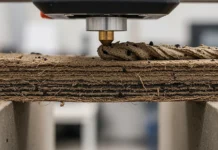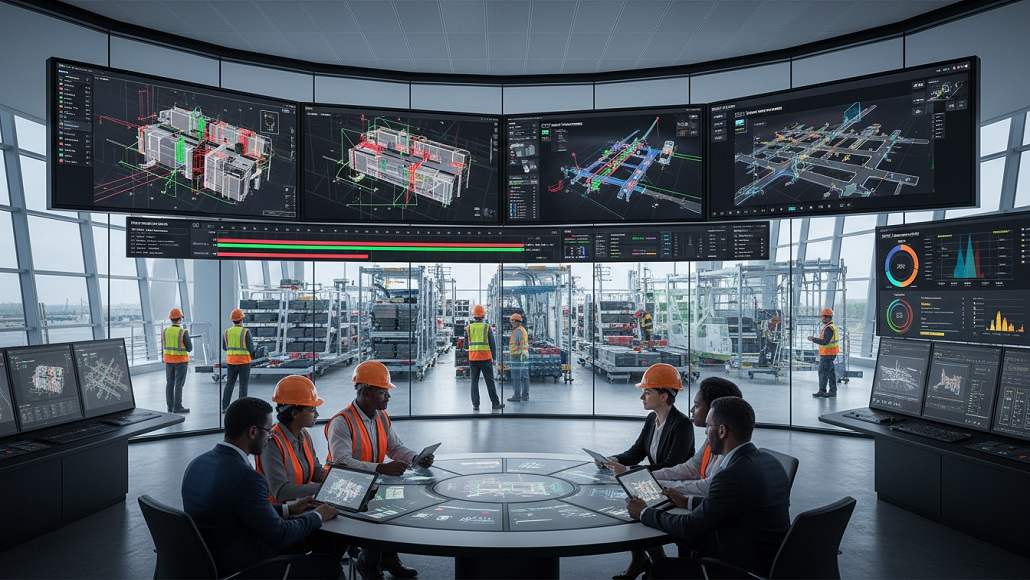BIM and Virtual Construction Shaping the Next-Generation Terminal
The integration of Building Information Modeling and virtual construction in terminal projects has fundamentally transformed how complex transportation infrastructure is designed, coordinated, and delivered. BIM and virtual construction in terminal projects represent more than technological upgrades; they constitute comprehensive methodological shifts toward data-driven decision-making, enhanced collaboration, and optimized project outcomes that address the unique challenges of terminal development.
Modern terminal construction demands unprecedented levels of coordination between diverse systems, stakeholders, and operational requirements that traditional design and construction methods cannot adequately manage. The implementation of BIM platforms and virtual construction technologies enables project teams to visualize complex interactions, identify potential conflicts, and optimize solutions before physical construction begins, dramatically reducing risks and improving project outcomes.
The strategic value of BIM and virtual construction extends throughout project lifecycles, from initial conceptual design through long-term facility management, creating integrated digital ecosystems that support informed decision-making and continuous optimization of terminal performance. These technologies enable new levels of precision, efficiency, and collaboration that are essential for successful delivery of contemporary terminal projects.
Building Information Modeling Fundamentals in Terminal Design
BIM technology creates comprehensive three-dimensional digital representations of terminal facilities that integrate architectural, structural, mechanical, electrical, and operational systems within unified models. These models serve as centralized information repositories that enable all project participants to access current, accurate data while maintaining version control and coordination across complex multidisciplinary projects.
The level of detail and information richness in BIM models evolves throughout project phases, beginning with conceptual massing studies and progressing through detailed construction documentation and operational facility management data. This progression enables appropriate information development that supports decision-making at each project phase while building comprehensive digital assets that support long-term facility operations.
Parametric modeling capabilities within BIM platforms enable rapid evaluation of design alternatives and automatic updating of related building systems when changes occur. This capability proves particularly valuable in terminal design where operational requirements, passenger flows, and technical systems must be optimized simultaneously through iterative design processes that benefit from automated coordination and analysis capabilities.
Model-Based Collaboration and Coordination
BIM-enabled collaboration transforms traditional design coordination by providing shared digital environments where all project participants can contribute to unified models while maintaining discipline-specific expertise and responsibilities. This collaborative approach reduces information gaps and coordination errors while accelerating design development through concurrent activities rather than sequential workflows.
Interdisciplinary coordination through BIM models enables early identification of conflicts between architectural, structural, and building systems components that would otherwise require costly field resolution during construction phases. Automated clash detection and resolution processes provide systematic identification of coordination issues while supporting efficient resolution through design optimization rather than construction rework.
Virtual Construction Technologies and Applications
Virtual construction encompasses a broad range of technologies and methodologies that simulate construction processes within digital environments, enabling optimization of construction sequences, resource allocation, and logistics planning before physical construction activities begin. These simulations provide valuable insights into construction feasibility, identify potential bottlenecks, and support development of optimized construction strategies.
4D modeling integrates construction scheduling with BIM geometry to create time-based visualizations that demonstrate construction sequences and identify potential conflicts between construction activities and operational requirements. These visualizations support construction planning while enabling stakeholder communication about construction impacts and phasing strategies.
5D modeling adds cost information to BIM geometry and scheduling data, enabling comprehensive project cost management that tracks budget performance against construction progress while providing accurate forecasting of final project costs. This integration supports proactive cost management and enables rapid evaluation of change order impacts on both schedule and budget outcomes.
Construction Sequence Simulation
Virtual construction simulation enables detailed analysis of construction sequences, equipment requirements, and site logistics that optimize construction efficiency while minimizing operational disruptions. These simulations consider equipment capabilities, site constraints, and safety requirements to develop construction approaches that balance efficiency with risk management and operational continuity requirements.
Material flow simulation within virtual construction environments optimizes logistics planning for material delivery, storage, and installation while minimizing handling operations and reducing waste generation. These simulations support sustainable construction practices while improving construction efficiency and reducing project costs through optimized resource utilization.
Enhanced Decision-Making Through Data Integration
The integration of real-time data with BIM models creates dynamic digital twins that continuously update to reflect actual construction progress and performance conditions. This integration enables decision-making based on current, accurate information while providing predictive capabilities that anticipate potential issues and support proactive management responses.
Performance analytics derived from integrated BIM and construction data provide insights into construction productivity, quality trends, and resource utilization that support continuous improvement in construction processes. These analytics enable identification of best practices and optimization opportunities that improve both current project performance and future project planning.
Stakeholder communication benefits significantly from BIM-based visualization and data sharing that provides accessible, understandable information about complex technical subjects. Virtual reality and augmented reality applications enable immersive stakeholder experiences that improve understanding and support more informed decision-making about design options and construction approaches.
Real-Time Progress Monitoring
Integration of construction progress monitoring with BIM models enables automatic comparison of planned versus actual construction activities, providing immediate identification of schedule variances and quality issues that require management attention. Automated progress tracking reduces administrative burden while improving accuracy of project status reporting.
Quality assurance integration with BIM models enables systematic tracking of inspection results, deficiency resolution, and compliance verification that supports comprehensive quality management throughout construction phases. This integration provides audit trails and documentation that support quality certification and long-term warranty management.
Collaborative Project Delivery Models
BIM technology enables new project delivery approaches including Integrated Project Delivery and Design-Build methodologies that leverage enhanced collaboration capabilities to improve project outcomes. These delivery methods benefit from shared risk-reward structures and collaborative decision-making that BIM platforms facilitate through improved information sharing and coordination.
Early contractor involvement in BIM-based design processes brings construction expertise into design development phases, enabling optimization of constructability, cost efficiency, and schedule performance before design completion. This involvement reduces construction risks while improving design quality through practical construction knowledge integration.
Stakeholder engagement through BIM visualization and virtual reality experiences improves communication with end users, regulatory agencies, and community representatives who may lack technical expertise to understand traditional construction documents. These engagement tools build support for projects while ensuring that stakeholder needs are effectively incorporated into design solutions.
Integrated Design and Construction Teams
BIM platforms support formation of integrated project teams where design and construction participants collaborate throughout project development rather than operating in traditional sequential relationships. This integration enables concurrent optimization of design and construction approaches that improve overall project value while reducing delivery timelines.
Shared accountability models enabled by BIM transparency create incentives for collaborative problem-solving and continuous improvement that benefit overall project outcomes. These models align participant interests while leveraging collective expertise to address project challenges and optimize solutions.
Technology Integration and Interoperability
Modern BIM platforms integrate with numerous specialized software applications and construction technologies to create comprehensive digital ecosystems that support all aspects of terminal design and construction. Interoperability between different software platforms enables organizations to select best-in-class tools while maintaining data integration and workflow continuity.
Cloud-based BIM platforms enable global collaboration and real-time access to project information from any location, supporting distributed project teams and enabling continuous project coordination across different time zones and geographic locations. These platforms provide scalable infrastructure that accommodates varying project sizes and team compositions while maintaining consistent performance and security standards.
Mobile BIM applications extend model access to field personnel, enabling real-time reference to design information, quality control procedures, and progress tracking activities from construction locations. These applications improve field productivity while ensuring that construction activities align with design intent and quality requirements.
Data Management and Security
Comprehensive data management strategies ensure that BIM information remains accurate, secure, and accessible throughout project lifecycles while supporting long-term facility management requirements. Data governance procedures address version control, access permissions, and backup requirements that protect project information while enabling efficient collaboration.
Cybersecurity measures for BIM platforms protect sensitive project information while enabling necessary access for project participants. These measures include access controls, encryption protocols, and monitoring systems that prevent unauthorized access while supporting legitimate project activities and information sharing requirements.
Facility Management and Operations Integration
BIM models provide comprehensive digital representations of completed facilities that support efficient facility management and operations throughout building lifecycles. The integration of as-built information, equipment data, and operational procedures within BIM platforms creates valuable resources for maintenance planning, space management, and future modification projects.
Asset management integration with BIM models enables systematic tracking of building components, maintenance requirements, and lifecycle replacement planning that optimizes facility operations while minimizing long-term costs. This integration provides data-driven facility management capabilities that improve operational efficiency and equipment reliability.
Operational simulation using BIM models enables optimization of passenger flows, security procedures, and emergency response plans that improve terminal operations while ensuring compliance with safety and security requirements. These simulations support operational planning and staff training while enabling continuous optimization of terminal performance.
Digital Twin Operations
Digital twin technology extends BIM capabilities to include real-time operational data that enables continuous monitoring and optimization of terminal performance. These systems integrate sensor data, operational information, and maintenance records with BIM geometry to provide comprehensive facility management platforms that support data-driven decision-making.
Predictive maintenance capabilities enabled by digital twin integration anticipate equipment failures and optimize maintenance scheduling to minimize operational disruptions while reducing maintenance costs. These capabilities leverage operational data and equipment performance trends to enable proactive maintenance strategies that improve reliability and reduce lifecycle costs.
Future Developments and Innovation Opportunities
Artificial intelligence integration with BIM platforms promises enhanced automation of design optimization, clash detection, and construction planning activities that will further improve project efficiency and quality outcomes. AI-powered analysis of BIM data can identify patterns and optimization opportunities that human designers might overlook while enabling more sophisticated design exploration and optimization processes.
Machine learning applications will enable BIM platforms to learn from project experience and improve recommendations for future projects, creating continuously improving design and construction methodologies. These capabilities will leverage project data to identify best practices and optimize processes while building institutional knowledge that improves organizational capabilities.
Augmented reality integration with BIM models will enhance field visualization and construction guidance capabilities, enabling workers to visualize design intent and construction procedures directly within their field of view. These capabilities will improve construction accuracy while reducing training requirements and construction errors through intuitive visual guidance systems.
Sustainability and Performance Integration
Environmental performance integration with BIM models enables comprehensive sustainability analysis and optimization throughout design and construction phases. These capabilities include energy modeling, lifecycle assessment, and material optimization that support sustainable design goals while meeting performance and cost requirements.
Carbon footprint tracking integration with BIM platforms will enable comprehensive monitoring and management of project environmental impacts throughout design, construction, and operational phases. This integration will support sustainability reporting and optimization while demonstrating environmental stewardship to stakeholders and regulatory agencies.
The transformation of terminal construction through BIM and virtual construction technologies represents a fundamental evolution in how complex infrastructure projects are conceived, developed, and delivered. Organizations that master these technologies position themselves to deliver superior project outcomes while building capabilities that support continued success in increasingly competitive and demanding construction markets. The continued advancement of these technologies promises even greater benefits as innovation drives further improvements in construction efficiency, quality, and sustainability outcomes that benefit both project stakeholders and the broader communities served by modern terminal infrastructure.































